| H-6 MEDIUM BOMBER
中国空军H-6中型轰炸机 Date:2017-02-18 Source:Internet By:Globalmil Viewed: |
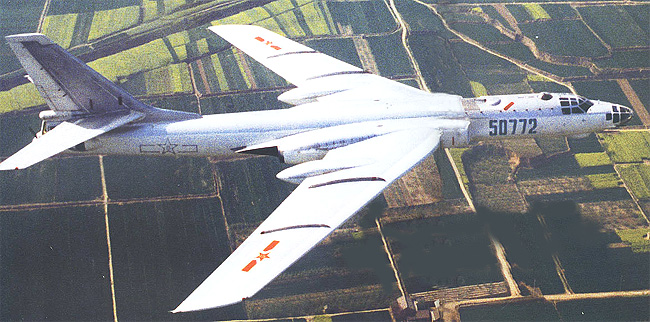
H-6以俄国Tu-16“獾”亚音速轰炸机为基础,最初在1940/50年发展当做一种中程轰炸机用于战术和战略轰炸任务。(The H-6 is based on the Russian Tu-16 Badger subsonic bomber originally developed in the 1940/50s as a medium-range bomber for tactical and strategic bombing missions.)
The Hong-6 (H-6, or B-6 in its export form) is a Chinese copy of the Russian Tupolev Tu-16 (NATO codename: Badger) twin-engine, medium-range bomber. It is the PLA’s principal medium- to long-range air strike platform. The aircraft is in service with the PLA Air Force (PLAAF) for strategic and tactical strike roles, and in the PLA Naval Air Force (PLANAF) for anti-ship missile attack role. A small number of modified H-6s are also serving as aerial refuelling tanker, reconnaissance aircraft, and ELINT platform.
中国空军“轰”(Hong)-6(H-6,或它的外销型为B-6) 是俄国双发动机、中程轰炸机Tupolev Tu-16的一种中国仿造型(北约代号:獾(Badger))。它是PLA的主要中程-到远程的空袭平台。飞机用于战略和战术打击任务在PLA空军(PLAAF)服役中,也在PLA海军空军 (PLANAF)中用于反舰导弹攻击任务。少量的经修改的 H-6也正在服役被当做空中加油机、侦察机和电子情报(ELINT)平台。
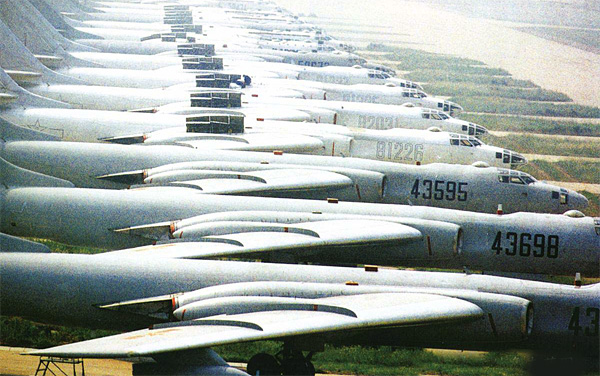
H-6是PLA的主要中程-到远程空中武器平台用于战术和战略对空中-遮断和海上攻击对抗任务。在这一张图片中显示是PLAAF和PLANAF H-6轰炸机的一个组合。海军的H-6能被他们较浅涂刷方案和空心序号区别。H-6加油机改型,在它的机翼下携带加油吊舱。(The H-6 is the PLA’s principal medium- to long-range aerial weapon platform for tactical and strategic air-interdiction and offensive counter maritime missions. Shown in this photo is a combination of PLAAF and PLANAF H-6 bombers. The naval H-6s can be distinguished by their lighter painting scheme and hollow serial numbers. The H-6 at forefront is a tanker variant with refuelling pods carried under its wings.)
PROGRAMME
计划
计划
The Tu-16 Badger medium-range bomber was developed by Tupolev Design Bureau in the late 1940s as a counter to the British Vulcan and USAF B-47 Stratojet. China obtained two Tu-16 examples and the technical documents in the late 1950s under the Treaty of Friendship, Alliance, and Mutual Assistance between China and Soviet Union. Two Tu-16s (known as H-6 in the PLA designations) assembled using Soviet-made kits by Harbin Aircraft Factory (now Harbin Aircraft Manufacturing Corporation, HAMC) were completed in 1959. The first successful flight took place on 27 September 1959.
俄国Tu-16“獾”中程轰炸机由图波列夫设计局在1940年后期发展,去对抗英国的Vulcan轰炸机和美国空军B-47 Stratojet轰炸机。中国在1950年后期在中国和苏联友谊、同盟和相互协助条约之下获得了二架Tu-16样机和技术文件。在1959年,由“哈尔滨”(Harbin)飞机厂(现在“哈尔滨”(Harbin)飞机制造公司,HAMC)使用苏联制造的零配件装配成功两架Tu-16(即是PLA指定的H-6)。首次成功飞行在1959年9月27日完成。
俄国Tu-16“獾”中程轰炸机由图波列夫设计局在1940年后期发展,去对抗英国的Vulcan轰炸机和美国空军B-47 Stratojet轰炸机。中国在1950年后期在中国和苏联友谊、同盟和相互协助条约之下获得了二架Tu-16样机和技术文件。在1959年,由“哈尔滨”(Harbin)飞机厂(现在“哈尔滨”(Harbin)飞机制造公司,HAMC)使用苏联制造的零配件装配成功两架Tu-16(即是PLA指定的H-6)。首次成功飞行在1959年9月27日完成。
The H-6 programme was seriously delayed in the early 1960s due to technical difficulties. Later the development was resumed at Xi’an Aircraft Factory in Xi’an, Shaanxi Province in March 1964. The indigenous model H-6A powered by two Chinese-built WP-8 turbojet engines made its maiden on 24 December 1968. The batch production of the H-6A began in 1969. Xi’an has also developed a number of variants including the H-6B reconnaissance aircraft, H-6C bomber with enhanced EW/ECM suite, H-6D anti-ship missile bomber, H-6E nuclear bomber, H-6F modernisation upgrade, H-6G LACM target guidance aircraft, H-6H air-to-surface missile bomber, H-6 tanker, and UAV carrier.
H-6计划在1960年早期严重地滞后归因于技术上的困难。1964年2月,稍后发展在陕西省西安(Xi'an)飞机工厂被重新开始。由二台中国制造的WP-8涡喷发动机提供动力的中国自行生产H-6A样机在1968年12月24日制造成功。H-6A的批量生产在1969年开始。西安(Xi'an)也已经发展的许多改型,包括H-6B侦察机、采用增强的电子战/电子干扰(EW/ECM)组件的H-6C轰炸机、H-6D反舰导弹轰炸机、H-6E核轰炸机、现代化升级的H-6F、H-6G LACM目标引导飞机、H-6H空对地火箭轰炸机、H-6加油机和无人机(UAV)运输机。
H-6 NUCLEAR BOMBER
H-6核轰炸机
H-6核轰炸机
One of the first two H-6 bombers assembled using Soviet-made parts was later converted by Xi’an as a nuclear bomber under codename “Mission 21-511”. The bomber was fitted with an air-conditioned bomb bay and special bomb mountings to carry a nuclear bomb. The bomber carried out China’s first air-drop nuclear test on 14 May 1965 by dropping a 20kT Fission (U235) atomic bomb at Lop Nor test site. On 29 September 1969, an H-6 bomber dropped China’s first thermonuclear bomb with a yield of 3,000kT. The dedicated nuclear bomber H-6E entered service in the 1980s.
使用苏联制造的零配件的最初二架装配的H-6轰炸机之一,后来被西安飞机厂在被称为代号“任务 21-511”下改装成一架核轰炸机。轰炸机配备有一个装有空调制冷的炸弹舱和特别的炸弹架,携带一枚核弹。轰炸机携带中国第一枚空投型核武器试验在在1965年5月14日进行,在罗布泊试验地点投下一枚20 kT裂变(U235)原子弹;1969年9月29日,一架H-6轰炸机投放中国第一枚3,000 kT的热核弹。中国专用核轰炸机H-6E在1980年中期进入了服役。
H-6D ANTI-SHIP MISSILE BOMBER
H-6D反舰导弹轰炸机
H-6D反舰导弹轰炸机
The H-6D is armed with two YJ-6 (export designation: C-601, NATO codename: CAS-1 Kraken) anti-ship missiles. The H-6D development began in 1975 and the aircraft entered service with the PLANAF in 1984. The aircraft is fitted with Type 245 target acquisition/illumination radar accommodated in the enlarged under-nose radome. At the altitude of 9,000m, the radar can detect a surface target of RCS 7,500 square metre 150km away. To perform long-range counter maritime operations, the H-6D is also fitted with improved avionics, including a new fire-control system that can be used for automatic navigation, automatic missile attack and semi-automatic level bombing.
H-6D携带两枚YJ-6(输出指定:C-601,北约代号:CAS-1 “巨妖”(Kraken))反舰导弹。H-6D发展在1975年开始,而且轰炸机在1984年进入PLANAF服役。飞机配备有245型目标捕获/照射雷达,安装在被扩大的机鼻天线罩中。 在9,000米的高度,雷达在150公里距离能发现RCS 7,500平方米的一个水面目标。为了要执行远程的海上对抗操作,H-6D也配备有改良的航空电子学设备,包括一个能用于自动导航、自动导弹攻击和半自动水平轰炸的新火控系统。
H-6D携带两枚YJ-6(输出指定:C-601,北约代号:CAS-1 “巨妖”(Kraken))反舰导弹。H-6D发展在1975年开始,而且轰炸机在1984年进入PLANAF服役。飞机配备有245型目标捕获/照射雷达,安装在被扩大的机鼻天线罩中。 在9,000米的高度,雷达在150公里距离能发现RCS 7,500平方米的一个水面目标。为了要执行远程的海上对抗操作,H-6D也配备有改良的航空电子学设备,包括一个能用于自动导航、自动导弹攻击和半自动水平轰炸的新火控系统。

海上轰炸机H-6D在机翼下携带二枚YJ-6(C-601)反舰导弹。飞机配备有245型目标捕获/照射雷达在增大的机头雷达天线罩中安装。(The maritime bomber H-6D carries two YJ-6 (C-601) anti-ship missiles under its wings. The aircraft is fitted with Type 245 target acquisition/illumination radar accommodated in the enlarged under-nose radome.)
The semi-active radar-homing YJ-6 was derived from the HY-2 ship-/land-based anti-ship missile. It is fitted with a 513kg high-explosive warhead, and can attack surface target 120km away at a speed of 0.9 Mach. Two missiles are carried by the under-wing pylons. With all of its 23mm cannons removed, the bomber relies entirely on its onboard electronic warfare (EW) suite and escort fighter aircraft for protection. The internal bomb bay is retained for conventional level bombing mission. Xi’an is also developing an improved variant of the H-6D carrying four more capable YJ-8 (C-801) anti-ship missiles.
半主动雷达-自导引的YJ-6起源于HY-2 舰-/陆基反舰导弹。它配备有一枚513公斤高爆弹头,能以0.9 Mach的速度在120公里之远攻击水面目标。二枚导弹被安装在机翼挂架下携带。为此飞机全部移除了23毫米机炮,轰炸机为自身保护,完全依赖机载电子争(EW)组件和护航战斗机。内部的炸弹舱用于传统水平轰炸任务被保留。 西安飞机厂也正在发展H-6D的一种改进型,携带四枚更有能力的YJ-8(C-801)反舰导弹。
H-6F MID-LIFE UPGRADE
H-6F中期寿命升级
Some H-6A and C models received mid-life modernisation upgrade in the early 1990s to extend their service life. The most significant improvement is the introduction of an integrated navigation system comprising three navigation methods—inertial, global position system (GPS), and a Doppler navigation radar. The original manually operated bombing sight was replaced by an automatic fire-control system, enabling the bomber to perform long-range air-interdiction and offensive counter maritime missions at low-altitude in all-weather, day/night conditions. Other modifications including light-grey low visibility colour scheme and the removal of the 23mm nose cannon.
一些H-6A和C型接受中期寿命现代化升级去延长有效寿命在1990年早期。最重要的进步是引进综合导航系统,由三种导航方式惯性、全球定位系统(GPS)和一部多普勒导航雷达组成。最初手动操作炸弹瞄准系统被一套自动火控系统代替, 促成轰炸机能在全天候、昼/夜低空执行运程空中-遮断和海上进攻对抗任务。其他的修改包括亮灰色低能见色方案和移除前端23毫米机炮。
一些H-6A和C型接受中期寿命现代化升级去延长有效寿命在1990年早期。最重要的进步是引进综合导航系统,由三种导航方式惯性、全球定位系统(GPS)和一部多普勒导航雷达组成。最初手动操作炸弹瞄准系统被一套自动火控系统代替, 促成轰炸机能在全天候、昼/夜低空执行运程空中-遮断和海上进攻对抗任务。其他的修改包括亮灰色低能见色方案和移除前端23毫米机炮。
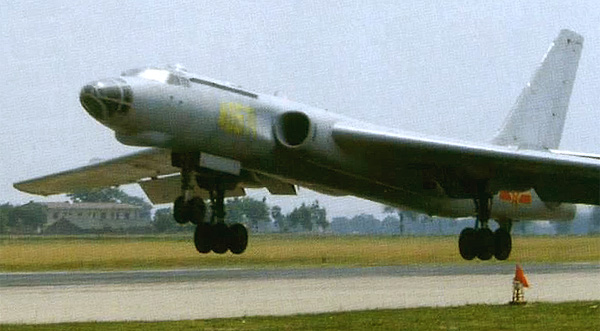
在1990年早期,一些H-6A轰炸机接受中期寿命现代化升级去延长它们的有效寿命到21世纪之内。这些轰炸机以改良导航和火控系统为特色。(Some H-6A bombers received mid-life modernisation upgrade in the early 1990s to extend their service life into the 21st century. These bombers feature improved navigation and fire-control system.)
The H-6E is incapable of delivering guided weapons for precision strike. Therefore it is intended to be used mainly as a maritime bomber for conventional level bombing against surface ships, where the enemy air defence is relatively weak. The bomber is highly vulnerable to the modern ground-based air defence system.
H-6E不能递送制导武器用于精确打击。因此它预计主要被当做一种海上轰炸机用于传统水平轰炸对抗水面舰艇,在敌人空中防御相对薄弱的地方。轰炸机非常易受现代化的地基防空系统攻击。
H-6H MISSILE BOMBER
H-6H导弹轰炸机
Xi’an resumed the H-6 production in the late 1990s to meet the PLA’s requirements for an aerial platform to deliver the new stand-off precision strike weapon. The improved H-6H features a distinctive radome under the rear fuselage for command link between the missile and the bomber. The H-6H carries two KongDi-63 (KD-63) air-launched land attack cruise missiles (LACM) under its wings, and has all 23mm cannons removed to give space for electronic equipment.
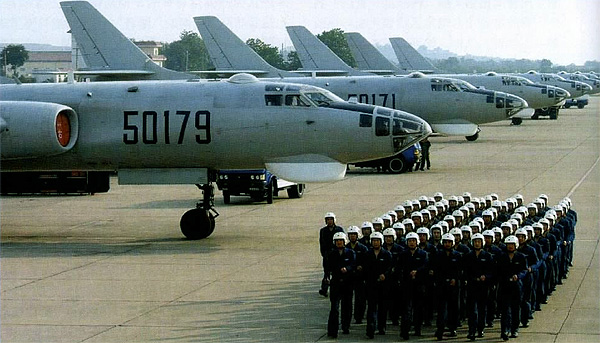
在2000年初期,40年之久的H-6轰炸机在西安飞机厂(XAC)重新开始恢复小批量生产,用于一种空中平台递送远距离精确打击武器去实现PLA的需求。(The 40-year-old H-6 bomber resumed limited production at Xi’an Aircraft Industry Company (XAC) in the early 21st century to fulfil the PLA’s requirement for an aerial platform to deliver stand-off precision strike weapons.)
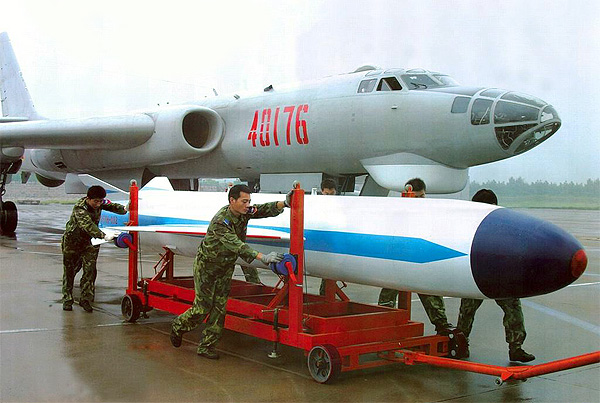
最近改进型H-6H在机翼下携带两枚“空地”(KongDi)-63(KD-63)空射对陆攻击巡航导弹(LACM)。所有的23毫米机炮被移除,提供给电子设备空间。一个有特色的天线罩用于导弹和轰炸机之间的指令线路位于后机身下。(The latest improved variant H-6H is armed with two KongDi-63 (KD-63) air-launched land attack cruise missiles (LACM) carried under its wings. All 23mm cannons were removed to give space for electronic equipment. A distinctive radome is located under the rear fuselage for command link between the missile and the bomber.)
西安飞机厂开始在1990年后期恢复H-6生产去满足PLA的需求用于一种空中的平台递送新式远距离高精确度打击武器。用于在导弹和轰炸机之间的指令线路改良H-6H 在后机身下面有一个有特色的天线罩。H-6H在机翼下携带二枚 “空地”(KongDi)-63(KD-63)空中发射对陆攻击巡航导弹(LACM),并且移除所有的23毫米机炮提供给电子设备空间。

在2000年初期,40年之久的H-6轰炸机在西安飞机厂(XAC)重新开始恢复小批量生产,用于一种空中平台递送远距离精确打击武器去实现PLA的需求。(The 40-year-old H-6 bomber resumed limited production at Xi’an Aircraft Industry Company (XAC) in the early 21st century to fulfil the PLA’s requirement for an aerial platform to deliver stand-off precision strike weapons.)

最近改进型H-6H在机翼下携带两枚“空地”(KongDi)-63(KD-63)空射对陆攻击巡航导弹(LACM)。所有的23毫米机炮被移除,提供给电子设备空间。一个有特色的天线罩用于导弹和轰炸机之间的指令线路位于后机身下。(The latest improved variant H-6H is armed with two KongDi-63 (KD-63) air-launched land attack cruise missiles (LACM) carried under its wings. All 23mm cannons were removed to give space for electronic equipment. A distinctive radome is located under the rear fuselage for command link between the missile and the bomber.)
The KD-63 LACM appears to be based on the design of the YJ-6 air-launched anti-ship missile, but with a X-shape tail. Its turbojet may be based on that of the HY-4 land-based anti-ship cruise missile. The KD-63 reportedly uses inertial/GPS mid-course with a TV terminal guidance seeker, carrying a 500kg warhead to 150~200km at 0.9 Mach. The H-6H first flew in December 1998, and made its first successful KD-63 test fire in November 2002. The aircraft entered operational service possibly in 2004~2005.
KD-63 LACM似乎以YJ-6空射反舰导弹的设计为基础,但是采用一种X-形尾翼。它的涡轮发动机可能以HY-4陆基反舰巡航导弹的为基础。KD-63根据传闻使用一套电视终端制导导引头和惯性/全球定位系统,飞行速度0.9 Mach,携带一枚500公斤弹头,射程150~200公里。H-6 H在1998年12月进行首次飞行,而且在2002年11月成功进行第一次KD-63发射测试。飞机在2004~2005年可能进入了操作服役。
DEPLOYMENT
H-6H导弹轰炸机
H-6H导弹轰炸机
Currently around 120 planes are deployed by the PLAAF 8th Air Division (Hengyang, Hunan Province), 10th Air Division (Anqing, Anhui Province) and 36th Air Division (Wugong, Shaanxi). The PLANAF also deploys some H-6A/D/F bombers.
在1990年后期,西安飞机厂重新开始了H-6生产去满足PLA的需求用于一种空中平台递送新型远距离精确打击武器。为在导弹和轰炸机之间的命令环的改进型H-6H的特点一个与众不同的雷达罩在后机身下用于导弹和轰炸机之间的指令线路。H-6H在机翼下携带二枚“空地”(KongDi)-63(KD-63)空射对陆攻击巡航导弹(LACM),并且移除了所有23毫米机炮用于提供给电子设备空间。
DESIGN
设计
设计
The H-6 has mid-mounted, swept-back wings with blunt tips, fences on top of the wings, and landing gear pods extend beyond the wings trailing edges. Two WP-8 turbofans are mounted in wing roots which extend beyond the leading and trailing edges of the wing root. The engines have a pair of round air intakes. The fuselage is long, slender, and bulging where the engines are mounted and tapered to the tail. The aircraft has a round, glassed-in nose and a stepped cockpit. The tail is swept-back, tapered fin and flats with blunt tips and a tail gunner compartment.
H-6有中部安装,后掠翼采用尖端背翼,在机翼顶部有翼刀,而且起落架舱延伸到机翼后缘。二台WP-8涡轮发动机被安装在翼根延长到扩充超过领先而且翼基部的後缘基部中。发动机有一对圆形进气口。细长机身,而且发动机凸出安装,锥形尾部。飞机有一个圆形、玻璃前端和一个阶梯式驾驶座舱。后掠尾部,锥形垂直尾翼和??一个尾部炮手舱。
The aircraft has a under-chin radome to accommodate the navigation radar. There are five crewmembers onboard: Two pilots seated in the central cockpit, each with an independent flight control; a navigator and a bombing aimer seated in the glassed-in nose compartment, and a rail gunner seated in the tail compartment. All crews are equipped with eject seats (two upwards, two downwards), but these seats were reported to give low chance for surviving in accidents.
飞机有一个机身前下方雷达天线罩去容纳导航雷达。飞机上有五名乘员:在座舱中部有两名驾驶员;一名导航人员和一名炸弹瞄准员在玻璃前端隔舱内,一名导轨弹药员?的座位在后舱。所有的乘员被装备使用弹射座椅(二名向上,二名向下),但是这些位子据称在故障中提供较低概率生存机会。
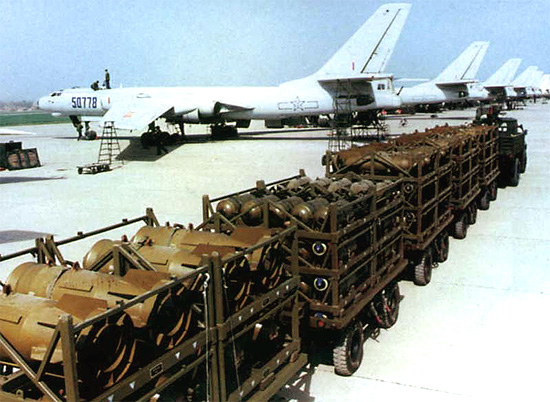
早期型号H-6仅仅有能力执行传统轰炸任务,在最新型号中由于广泛采用现代化升级,能够执行战术和战略打击任务,使用精确打击武器和航空炸弹。(Early variant H-6 is only capable of conventional level bombing missions, but due to extensive modernisation upgrades the later variants are capable of tactical and strategic strike missions using precision strike weapons as well as free-fall bombs.)
POWERPLANT
动力装置
动力装置
The aircraft is powered by two Xi'an (XAE) WP-8 (Mikulin AM-3M-500) turbojets, with a maximum thrust of 20,944 lb (93.16 kN) dry each.
飞机安装二台西安飞机厂WP-8(Mikulin AM-3M-500)涡轮发动机,每台最大净推力20,944磅(93.16 kN)。
WEAPONS
武器
武器
Up to 9000kg (normally 3,000kg) of disposable stores are carried in a lower-fuselage weapon bay capable of accepting nuclear and/or 250/500/1,500/3,000 kg high-explosive (HE) free-fall bombs.
最大一次性负载9000公斤(正常地3,000公斤),携带在机身下面武器挂架,能够接收核或250/500/1,500/3,000公斤高爆弹药(HE)航空炸弹。
Early variant H-6 also has seven 23mm cannons, with one single-barrel mounted on the starboard side of the glass-nose, three twin-barrels mounted in defensive turrets located on the back and belly of the fuselage and tail. These cannons are controlled by optical sight/fire-control radar. Later variants have some of all of these cannons removed.
早期型H-6也有七门23毫米机炮,一门单管安装在玻璃前端的右舷侧,三门双管安装在防御转塔位于机身和尾部的炉腹之上?。这些机炮采用光瞄准器/火控雷达控制。稍后改型已经部分或全部移除这些机炮。
Later variants also have two or four under-wing pylons to carry missiles.
稍后改型也有二个或四个机翼下挂架携带导弹。
SPECIFICATIONS
规格
规格
Crew: 5
Length: 34.8m
Wingspan: 34.2m
Hight: 9.85m
Normal take-off weight: 72,000kg
Maximum take-off weight: 75,800kg
Normal weapon Load: 3,000kg
Maximum weapon load: 9,000kg
Internal fuel: 33,000kg
Maximum speed: 1,014km/h;
Cruising speed: Mach 0.75 (786km/h)
Maximum range: 6,000km
Combat radius: 1,800km
Service ceiling: 13,100m
组员: 5
机长: 34.8 m
翼展: 34.2 m
机高: 9.85 m
正常起飞重量: 72,000 kg
最大的起飞重量: 75,800 kg
正常武器负载: 3,000 kg
最大的武器负载: 9,000 kg
内部燃料: 33,000 kg
最大速度: 1,014 km/h;
巡航速度: Mach 0.75(786 km/h)
最大航程: 6,000 km
战斗半径: 1,800 km
实用升限: 13,100 m
上一篇:没有了 下一篇:H-5 Light Bomber[Il-28 BEAGLE (ILYUSHIN)]
| H-5 Light Bomber[Il-28 BEAGLE (ILYUSHIN)]
中国H-5型[伊尔-28“猎兔犬”(ILYUSHIN)]轻型轰炸机 |
| This aircraft was produced in China under the nomenclature H-5. The H-5 was a light subsonic bomber with a cantilever high set wing.... [2020-04-07] |
| H-6 MEDIUM BOMBER
中国空军H-6中型轰炸机 |
| The Hong-6 (H-6, or B-6 in its export form) is a Chinese copy of the Russian Tupolev Tu-16 (NATO codename: Badger) twin-engine, medium-range bomber. It is the PLA’s principal medium- to long-range air strike platform. ... [2017-02-18] |
